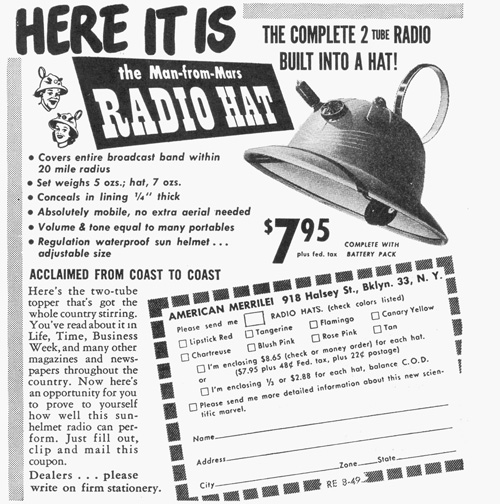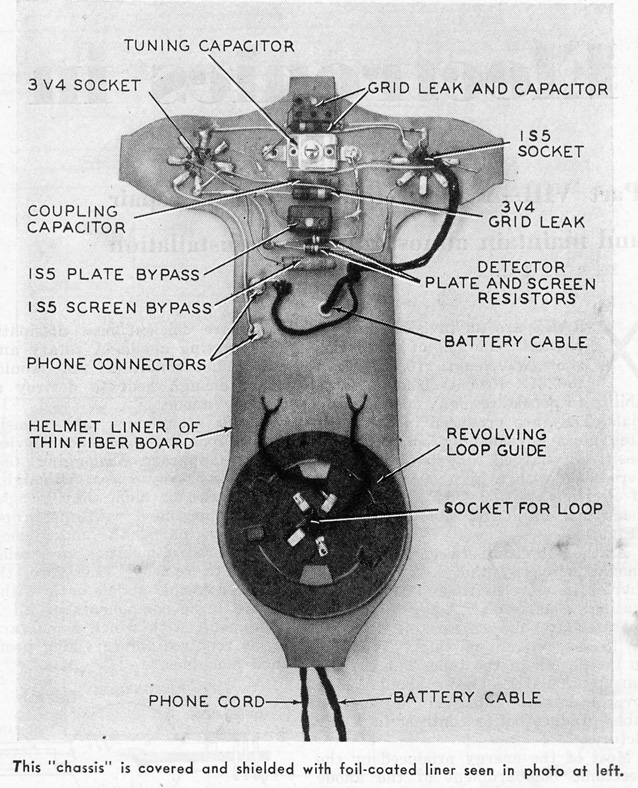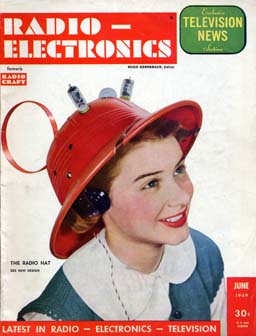This is exemplified by an entirely new radio receiver - the Radio Hat - illustrated on the cover of this magazine. Communication, reception of news, time and weather reports, are a constant necessity to people in this country. So is a light and portable receiver, such as the Radio Hat, illustrated in these pages.
As a new article of manufacture, it will probably cause no little sensation in this country during the next few months. Originally the manufacturer of the Radio Hat believed that the item was geared for the use of youngsters only. It would seem indeed that on account of its low price -below $8.00- it will find a large market in this particular sphere. Boy Scouts and youngsters on their vacations, whether in the country or at the beach, will be avid buyers of an article of this type.
Grown-ups, however, will buy it as a stunt and for emergency purposes or sports, such as hiking, canoeing, and boating.
The editors made a number of tests on the Radio Hat and found it to be an exceptionally efficient receiver, particularly for outdoor purposes. In and around New York City, practically all the locals came in with excellent volume. An efficient modified ultraudion circuit is used and the separation of stations is clean and effective. The set is tuned with a control located between the two tubes on top of the hat.
The device was found to be quite directional and for this reason the rotatable loop antenna should be used, unless the wearer of the hat turns on his own axis to get the best reception.
A number of tests were also made indoors. Reception was fair, even in steel buildings; good in non-steel buildings.
The battery, incidentally, is made up of one 22½-volt B-battery and two 10¢ A-batteries. These are contained in a carton which is kept in the pocket and is connected to the hat with a flexible short lead cord.
Hugo Gernsback, Editor-in-Chief

One of the most useful and eye-catching radio novelties in a long time is the Radio Hat, a new type of personal receiver manufactured by the American Merri-Lei Corporation of Brooklyn, N. Y. It is a sensitive little two-tube set built into a tropical-type helmet with the tubes projecting from the front like two small horns.
Its tuning control is a small, streamlined bar knob mounted between the tubes. The antenna (and tuning inductor) is a 5-inch loop, 1/2 inch wide, mounted vertically on the rear of the crown. It fits into a socket that permits rotation through 90 degrees for directional effects. A single headphone is built into the inside of the hat just over one ear.
 Power is supplied by a tiny 8-ounce battery pack that fits into a pocket and
connects to the set through a 36-inch length of thin 3-conductor wire. The
appearance of the set is bizarre but strangely impressive, as seen in the
photographs.
Power is supplied by a tiny 8-ounce battery pack that fits into a pocket and
connects to the set through a 36-inch length of thin 3-conductor wire. The
appearance of the set is bizarre but strangely impressive, as seen in the
photographs.
At a glance, this "man-from-Mars" personal radio would appear to be a child's
toy but after using it for a few hours, we began to see its possibilities.
For example, it is just the thing for baseball fans who want to keep up with the
doings of the out-of-town teams while rooting for the home-town favorites in the
local ball park. Followers of the sport of Izaak Walton will be wearing their
radios as they head-rod and reel in hand-for a spot on the banks of the old mill
stream. For beaches, hiking, bicycling, picnics, or strolling in the park, the
Radio Hat will prove its worth to all who wear it.
Substantial and water-resistant, the Radio Hat weighs only 12 ounces and can be
fitted to any size head by adjusting the leather sweatband. Twelve ounces may
seem heavy for a hat until compared with the five to seven ounces of the average
man's hat. The Radio Hat fits well and can be worn at almost any angle. Probably
young ladies will wear it perched on the back of their heads (see this month's
cover) and youthful gay blades can wear it tipped jauntily over one eye. The
phone is over the left ear but can be moved to the right if the wearer desires.
The Radio Hat is made in such gay colors as canary yellow, lipstick red,
turquoise, chartreuse, tangerine, lavender, blue, and cerise for teen-agers. and
in tan, gray, green-gray, and bluegray for adult.
The circuit
The circuit of the Radio Flat is shown in the diagram. The 1S5 is connected as a
modified ultraudion detector. Its tuned circuit consists of the loop and a small
compression-type capacitor with the control knob on the front between the tubes.
The audio amplifier is a 3V4 pentode, resistance-coupled to the detector. Bias
for the amplifier is developed across its 20-megohm grid resistor. The single
phone is in the plate circuit of the 3V4 where it provides sufficient volume for
local stations.

The power supply is a small battery pack that supplies 1½ volts for the
filaments and 22½ volts for the plates and screen grids. The A-battery is a
standard No. 2 flashlight cell that will last as long as 20 hours with
intermittent use. Replacement battery packs will be available at retailers or
from the manufacturer. These are 2½ x 2½ x 1¼ ; inches, housing the A- and
B-batteries. The A-battery is held in the pack with spring-brass clips that
connect to the battery terminals.
The batteries connect to the set through a 3-prong connector and a thin flexible
cable. There is no switch. The set is turned on by plugging the battery cable
into the socket on the pack.
The selectivity is surprisingly good. It separates stations much better than
some 4-tube t.r.f. sets. Like most regenerative detectors, this one requires
careful adjustment of the tuning control and antenna for best reception.
The manufacturer states that when the Radio Hat is put on the market, its tubes
will be coated with a tough plastic that will prevent damage from flying glass
should a tube be broken.

